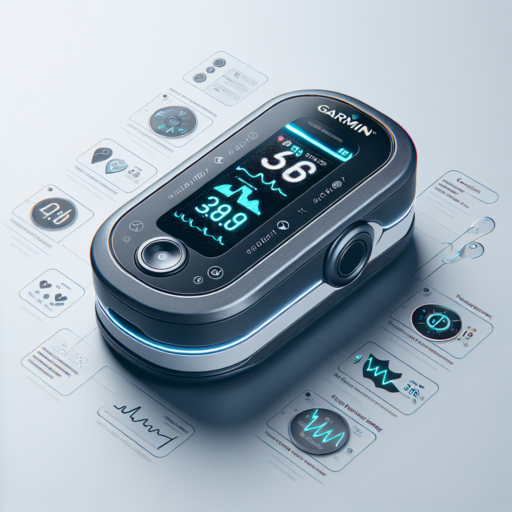Introduction to Pulse Oximeter Feature in Garmin Devices
The evolution of wearable technology has seen a noteworthy addition to its capabilities in recent years, with the introduction of the pulse oximeter feature in Garmin devices. This remarkable feature represents a significant leap forward in monitoring and understanding one’s health and wellness directly from the wrist. The pulse oximeter, primarily used for measuring the saturation of oxygen in the blood (SpO2), has become an indispensable tool for athletes, fitness enthusiasts, and health-conscious individuals alike.
Why has Garmin incorporated this feature into its wearable devices? The answer lays in the increasing awareness and focus on not just external fitness but also internal health metrics. Understanding oxygen levels in the blood can provide critical insights into a person’s overall health, including sleep quality, altitude acclimatization, and even the detection of potential health issues. With Garmin’s innovative approach, users can now access this vital information with ease and precision, integrating it seamlessly into their daily health and fitness routines.
How does it work? At its core, the pulse oximeter feature utilizes light beams to estimate the amount of oxygen in your blood, based on how the light passes through your skin. This non-invasive method offers a convenient and immediate way to check oxygen saturation levels, which can fluctuate due to various factors such as physical activity, altitude, and sleep patterns. Notably, Garmin devices present this data in an easy-to-understand format, allowing users to monitor their SpO2 levels and make informed decisions about their health and wellness strategies.
How Does the Garmin Pulse Oximeter Work?
The Garmin Pulse Oximeter operates by leveraging photoplethysmography technology to monitor the oxygen saturation levels (SpO2) in your blood. This innovative feature found in select Garmin wearables aims to help users assess their overall health and wellness, especially those involved in high-altitude activities or anyone interested in a better understanding of their fitness levels. But how exactly does this tool work, and what makes it stand out?
At its core, the Garmin Pulse Oximeter utilizes two LED lights (one red and one infrared) on the back of the wearable device. These lights shine onto the skin, penetrating the blood vessels beneath. As blood cells move through your veins, they absorb varying amounts of light, depending on how much oxygen they carry. The device then measures the light that is reflected back from your blood, using an advanced algorithm to calculate your blood’s oxygen saturation. The entire process is non-invasive, making continuous or on-the-spot checks convenient and painless.
It’s crucial to understand that while Garmin’s Pulse Oximeter feature offers valuable insights into your health and fitness, it’s not intended for medical use. Instead, by giving users data on their oxygen levels during sleep, rest, or high-altitude activities, it enables a deeper understanding of their body’s adaptation and recovery needs. This function is particularly beneficial for athletes, hikers, or anyone engaging in activities that might influence their oxygen saturation levels.
Understanding the Benefits of Using Pulse Oximeter on Garmin Watches
Enhanced Health Monitoring
The integration of pulse oximeter technology into Garmin watches has significantly enhanced the scope of health monitoring for its users. This feature allows for the continuous tracking of blood oxygen saturation (SpO2) levels, offering insights into your body’s oxygen usage. By monitoring these levels, users can better understand their physiological condition during various activities, such as high-altitude hiking or intense physical training. This real-time data empowers individuals to make informed decisions about their health and fitness routines.
Improved Sleep Quality Analysis
Another noteworthy benefit of utilizing the pulse oximeter function in Garmin watches is the ability to analyze sleep quality more accurately. Garmin devices use SpO2 measurements to assess how well your body is breathing during sleep, which is a crucial aspect of sleep health. Having access to this information enables users to identify patterns or issues that may be affecting their sleep, such as sleep apnea. With this data at their fingertips, users can take proactive steps towards improving their sleep quality and, by extension, their overall well-being.
Altitude Acclimation Insights
For adventurers and athletes who frequently find themselves at high altitudes, the pulse oximeter feature on Garmin watches can be especially beneficial. Monitoring SpO2 levels helps to gauge how well one is acclimating to higher elevations and lower oxygen environments. This is particularly useful for preventing altitude sickness by offering vital clues when to rest or when it’s safe to proceed with physical exertion. Thus, it ensures a safer and more enjoyable experience in challenging conditions.
Step-by-Step Guide to Using the Pulse Oximeter Function on Your Garmin
Understanding your oxygen levels during various activities can provide valuable insights into your overall health and fitness. Garmin devices with the pulse oximeter feature offer a non-invasive method to monitor your blood oxygen saturation (SpO2). This guide will walk you through the steps to effectively use this innovative function.
Activating the Pulse Oximeter Function
Before you can start monitoring your SpO2 levels, it’s essential to activate the pulse oximeter function on your Garmin device. Navigate to the settings menu, select the Sensors & Accessories option, and then choose Pulse Ox. Here, you’ll have the option to enable the feature for all-day monitoring or just during sleep. It’s recommended to explore both settings to understand how your oxygen levels vary during different states of activity and rest.
Interpreting Your Pulse Oximeter Data
Once you’ve activated the function and worn your device for a few hours or a night, you can start to analyze the data. Your Garmin will display your SpO2 percentage—a measure of the oxygen saturation in your blood. Typically, a reading between 95% to 99% is considered normal for healthy individuals. However, factors such as altitude or certain health conditions can influence your results. Reviewing this data regularly can help you recognize trends or changes in your oxygen levels, which may warrant further investigation or a conversation with your healthcare provider.
The Accuracy of Garmin’s Pulse Oximeter: What You Need to Know
The accuracy of Garmin’s pulse oximeter has become a topic of increasing discussion among fitness enthusiasts and health-conscious individuals. As a feature integrated into many of Garmin’s smartwatches, the pulse oximeter measures blood oxygen saturation levels, an essential biomarker for assessing respiratory function and overall health. Understanding the precision and reliability of these readings is crucial for users who rely on this data to make informed decisions about their health and fitness routines.
Factors Influencing Accuracy: Several elements play a pivotal role in the accuracy of Garmin’s pulse oximeter readings. First and foremost, the position and tightness of the smartwatch on the wrist can significantly influence the accuracy. Furthermore, skin pigmentation, ambient light, and current blood flow all interact to affect the sensor’s ability to capture precise measurements. Garmin continuously refines its technology to mitigate these factors, ensuring users receive reliable and precise data.
Understanding the Limitations
While Garmin’s pulse oximeter offers valuable insights into one’s health metrics, it is important to recognize the inherent limitations of wrist-based oximetry. Unlike medical-grade oximeters, which attach directly to the fingertip or earlobe for direct blood flow measurement, wrist-based sensors face challenges in capturing constant, unimpeded readings. This doesn’t discount the utility of Garmin’s pulse oximeter but highlights the importance of using it as a supplemental tool alongside other health assessments.
Comparing Garmin’s Pulse Oximeter to Other Market Options
When considering the variety of health monitoring tools available today, Garmin’s pulse oximeter stands out for its integration within high-end fitness trackers and smartwatches. Unlike standalone pulse oximeters, Garmin devices offer a comprehensive view of your health by combining pulse oximetry with other fitness and wellness tracking features. This multi-functional approach provides a distinct advantage over traditional, single-purpose pulse oximeters.
One key factor that sets Garmin’s pulse oximeter apart is its convenience and user-friendliness. While most market options require you to stop what you’re doing to take a reading, Garmin devices continuously monitor your blood oxygen saturation (SpO2) levels in the background, both during the day and while you sleep. This passive tracking method means you get valuable insights into your SpO2 trends over time, without any extra effort on your part.
In contrast, other market options might offer more specialized features or higher accuracy in controlled conditions. Professional-grade standalone pulse oximeters are often used in medical settings for their precision; however, they lack the holistic health insights provided by smart device integration. Garmin’s merge of pulse oxygen monitoring with fitness tracking, heart rate monitoring, and stress tracking presents a unique value proposition for those looking to understand their overall health and fitness landscapes.
No se han encontrado productos.
Optimizing Your Health Monitoring with Garmin’s Pulse Oximeter Features
In the digital era, health monitoring has transcended traditional methods, offering insights into our well-being with unprecedented convenience and efficiency. Among the leading advancements in this domain is Garmin’s integration of pulse oximeter features in its devices. This technology not only tracks your oxygen saturation levels but also plays a pivotal role in understanding your overall health and fitness levels. Garmin’s pulse oximeter functionality is designed for everyday use, providing you with critical data that can help optimize your health monitoring routine.
Utilizing Garmin’s pulse oximeter features effectively can enhance your understanding of how your body responds to various physical activities and environmental changes. This insight is invaluable for athletes, hikers, and anyone interested in maintaining an optimal health regime. The feature tracks changes in blood oxygen levels, allowing users to adjust their activities and rest periods based on accurate physiological data. By observing trends over time, you can make informed decisions about your health and fitness strategies, ensuring you’re not just working out smarter, but also safer.
Moreover, Garmin’s pulse oximeter offers the convenience of passive monitoring during sleep. This aspect of health monitoring is often overlooked, yet it is crucial for a comprehensive understanding of your wellness. Sleep quality directly impacts our cognitive functions, mood, and general health. Garmin’s technology provides insights into your nighttime oxygen levels, highlighting potential issues such as sleep apnea without the need for intrusive devices. It’s an essential tool for those keen on maximizing their health through improved sleep quality.
Common Issues and Troubleshooting Tips for Garmin’s Pulse Oximeter
Garmin’s Pulse Oximeter feature, integrated into its latest smartwatches and fitness trackers, offers users a convenient way to monitor their blood oxygen saturation (SpO2) levels, a critical marker of respiratory health. Despite its utility, some users may encounter issues affecting the device’s accuracy and functionality. Understanding these problems and applying the right troubleshooting tips can ensure that you continue to receive reliable data to support your health and fitness goals.
Issue 1: Inaccurate SpO2 Readings
One of the most common issues reported with Garmin’s Pulse Oximeter is inaccurate SpO2 readings. Such discrepancies can arise from improper wear of the device or external factors affecting blood flow. To address this, make sure your Garmin device is snug but comfortable on your wrist, positioned above the wrist bone. It’s also advised to keep still for a few minutes before taking a reading to avoid skewed data caused by movement. Additionally, ensure that your skin is clean and free from heavy lotions or perfumes that might interfere with the sensor’s functionality.
Issue 2: Difficulty Activating Pulse Oximeter
Another hurdle users might face is trouble activating the Pulse Oximeter feature. This issue often stems from software glitches or outdated firmware. First, verify that your Garmin device supports the Pulse Oximeter function. If it does, attempt a soft reset of your device or ensure that your firmware is up to date through the Garmin Connect app. This can resolve many of the minor software issues that could be preventing the Pulse Oximeter from functioning correctly.
Issue 3: Rapid Battery Drain
Monitoring SpO2 levels, especially during sleep, can lead to rapid battery depletion. While this is somewhat expected due to the additional power required by the Pulse Oximeter sensor, there are ways to mitigate excessive battery drain. Consider customizing the tracking settings to only monitor your SpO2 levels at night or at specific intervals rather than continuously. Furthermore, dimming your screen brightness and turning off unnecessary notifications can help conserve battery life, ensuring that your Garmin device remains powered for longer periods.
User Experiences: How the Garmin Pulse Oximeter Enhances Fitness and Wellness Routines
The Garmin Pulse Oximeter is revolutionizing the way athletes and fitness enthusiasts approach their daily routines. Integrating seamlessly into wellness practices, this state-of-the-art tool offers insightful data that goes beyond basic fitness tracking. Through precise measurement of blood oxygen saturation levels, the Garmin Pulse Oximeter plays a pivotal role in personal health management. Users have reported significant enhancements in understanding their body’s needs, leading to more tailored and efficient workouts.
One of the key benefits of the Garmin technology lies in its ability to monitor oxygen levels during various states of activity and rest. This feature offers users a deeper insight into their physical condition, enabling them to adjust intensity levels in real time. For instance, during high-altitude training or strenuous exercises, tracking oxygen saturation can signal when to push forward or take a moment to recover. This level of monitoring empowers individuals to make informed decisions about their fitness regime, thereby optimizing performance and minimizing the risk of injury.
Moreover, the Garmin Pulse Oximeter has garnered praise for its contribution to improved sleep quality and overall wellness. By monitoring oxygen levels throughout the night, it provides valuable feedback on sleep patterns, highlighting areas for improvement. Users have experienced noticeable benefits in their energy levels and mental alertness, attributing these improvements to the advanced insights provided by the pulse oximetry feature. The integration of this device into daily life not only supports physical fitness goals but also enhances the pursuit of holistic well-being.
Future Updates: What to Expect From Garmin Regarding Pulse Oximetry
Garmin, a leader in the development of technology for fitness and outdoor activities, is continuously evolving to meet the needs of its user base. With a keen focus on health and wellness features, the anticipation surrounding future updates, particularly in the domain of pulse oximetry, is growing. This non-invasive method of monitoring the saturation of oxygen in one’s bloodstream has been a pivotal feature in many Garmin devices, offering insights into physical condition and altitude acclimatization.
The company’s commitment to enhancing user experience has sparked curiosity about how Garmin will innovate its pulse oximetry feature in upcoming releases. Experts in the fitness technology field speculate that Garmin might introduce improvements in accuracy, real-time monitoring capabilities, and integration with other health metrics. These enhancements could potentially elevate the user’s ability to track and understand their health and fitness levels in unprecedented ways.
Moreover, Garmin’s approach to data analysis and presentation within its ecosystem might see significant refinements. Users could look forward to more intuitive interfaces and personalized insights based on their pulse oximetry readings. This could involve the development of new algorithms that offer a deeper analysis of oxygen levels under various physiological conditions, such as sleep quality and high-intensity workouts.




